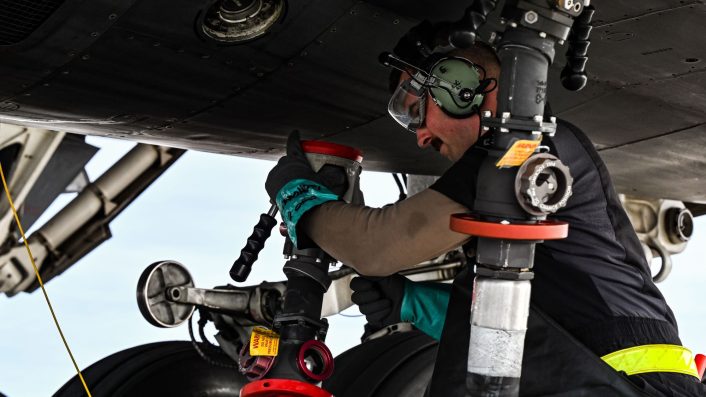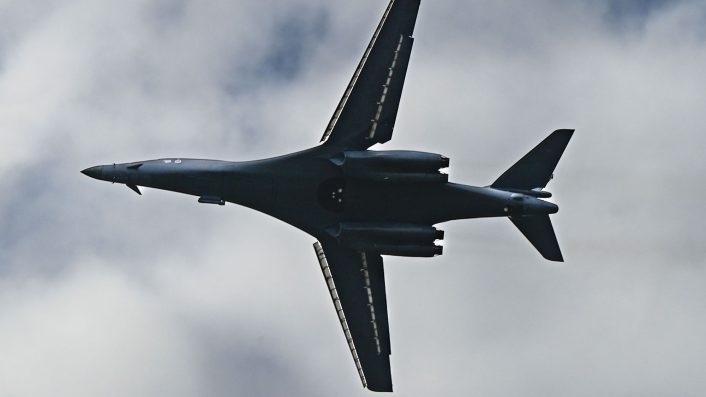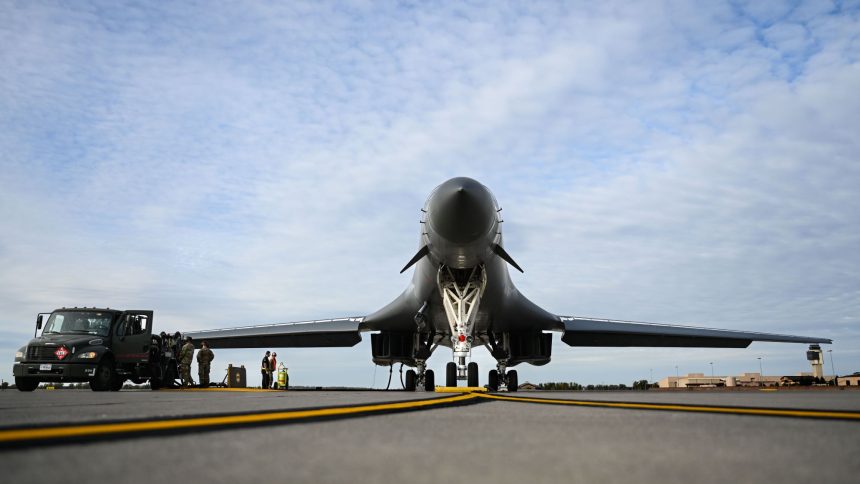The hot pit refuel drill demonstrated the B-1B Lancer is capable of operating from other air bases for strike missions in the backdrop of Ellsworth’s fleet possibly temporarily relocating to Grand Forks AFB, owing to a runway construction at Ellsworth to host the B-21 Raider in the future.
The 28th Bomb Wing from Ellsworth Air Force Base, South Dakota, with the help of the 319th Reconnaissance Squadron, performed the B-1B Lancer bomber’s first hot-pit refueling in 30 years at Grand Forks AFB, North Dakota, on Oct. 1, 2024. Grand Forks was previously a B-1B base, until the bombers were relocated in 1994.
The event tested the base and its Airmens’ adaptability in the backdrop of Ellsworth’s B-1B Lancer fleet possibly temporarily relocating to Grand Forks AFB, a release from the AFGSC (Air Force Global Strike Command) said. This is owing to a runway construction project at Ellsworth AFB in preparation for the future arrival of the B-21 Raider as its first operational base.
Hot-pit refueling operations are becoming quite routine for U.S. Air Force assets, often performed as a part of ACE (Agile Combat Employment) operations. The hot-pit refueling allows aircraft to rapidly refuel without powering down their engines. This increases operational readiness and reduces the time needed to get the aircraft back in action.
#Airmen from Ellsworth Air Force Base & Grand Forks AFB performed B-1B Lancer hot-pit refueling operations, supporting B-1 operations 30 years after the last B-1s left Grand Forks in 1994.
Take a look:https://t.co/tuUa91U7FI@AFGlobalStrike pic.twitter.com/t7dvMJSpEZ
— U.S. Air Force (@usairforce) October 8, 2024
The release indicated how the hot-pit refueling drill encompassed all techno-logistical, administrative and tactical-operational goals: familiarization, assessment of the infrastructure for the future hosting of the B-1B bomber, establishing coordination between Ellsworth’s and Grand Forks’ personnel, and keeping the B-1B fleet capable of operating from other air bases for strike missions.
This was also seen in Ellsworth AFB’s first full-scale readiness exercise in over a decade, called Raider Reach, late in September 2024. The drill saw the 28th Bomb Wing’s B-1B Lancers practicing flying daily long-range global strike missions during the exercise’s second phase.

Getting to know Grand Forks AFB again
As mentioned earlier, the hot-pit comes 30 years after the last of the B-1B Lancers left Grand Forks in 1994. Many of the physical infrastructure such as the required runway length, ordnance storage capacity, and aircraft refueling equipment are still present. Nevertheless, the 29th BW and the 319th RS still had to demonstrate the ability to operate the B-1B from non-home base locations.
“The ability to perform a hot-pit in an alternate location proves our ability to continue operating at 100 percent no matter where we are,” said in the release Staff Sgt. Jacob Szatkowski, 37th Bomber Generation Squadron’s dedicated crew chief. Prior to the drill, Airmen first traveled to Grand Forks to “test the equipment and to foster relationships between both Wings for potential collaborations in the future.” Assuming the USAF finalizes the proposed plan to shift Ellsworth’s bomber fleet to Grand Forks, it was necessary to demonstrate the ability of Ellsworth Raiders and Grand Forks Griffins “to work together and complete the refuel.”
The officially released pictures suggest that a single B-1B Lancer of the 28th BW landed at Grand Forks AFB. Upon landing, Szatkowski attached a fuel line to the bomber and a fuel truck could be seen beside the aircraft, possibly in a dedicated area of the apron. The captions described the B-1B bomber as the “backbone of America’s global precision strike force” that “operates in all types of weather conditions and any environment.” The caption also reminded that “B-1B Lancers carry the largest payload of both guided and unguided weapons in the Air Force inventory.”
Szatkowaski added that the present scope of coordination with the 319th Reconnaissance Wing involves “runway and airfield familiarization, as well as coordination for aircraft movement.” The familiarization and acquaintance between Ellsworth’s and Grand Forks’ crews “helped break the ice for any coordination needed in months to come.”
The success of the hot-pit refuel showed the Airmen keep the bomber fleet “ready to strike anytime, anywhere despite operating out of a temporary location,” according to the release,. Lt. Col. Nathaniel Butler, Commander Action Group director, said he was “really happy to see our bomber come and land here.” “Everything went exactly as we intended. It is always good to see the aircraft performing exactly as needed, and the fact this base is adequately appointed to support our operations works in our favor.”
The 28th BW noted it maintains its commitment to paving the way for the future of long-range strike as construction continues at Ellsworth AFB for the incoming B-21 Raider, while continuing to maintain the B-1B mission readiness.

B-1B Lancer and B-21 Raider relocations
The Aviationist had reported how Grand Forks AFB might host the B-1B Lancer again in 30 years after it left the base in 1994. The former 319th Bomb Wing then switched to a refueling and later a reconnaissance role, changing designation. The temporary B-1B move, which is scheduled to commence in Feb. 2025 and expected to last ten months, is however not definitive, as Air Force Global Strike Command and Grand Forks AFB officials told Air and Space Forces.
The final decision would be informed by the findings of an ongoing environmental review that will evaluate the impact of the relocation. Should the transfer be confirmed, 800 Airmen will move along the bombers for maintenance and operations’ support. Beside housing and transportation for the personnel, Grand Forks AFB might also need temporary hangars to house the B-1s.
The beauty that is a Rockwell B-1B Lancer. Did you know that Pentagon plans to start replacing the BOnes with Northrop Grumman B-21 “Raider” from 2025? All B-1Bs are expected to be retired by 2036 😞 pic.twitter.com/FSINA8mPyE
— Air Power (@RealAirPower1) October 8, 2024
As mentioned, the planned temporary relocation from Ellsworth to Grand Forks AFB is owing to infrastructure work at Ellsworth AFB to host the B-21 Raider bomber. This decision however is final, as Ellsworth was selected as the first B-21 Raider base after it cleared an EIA (Environmental Impact Assessment) report in 2021. Whiteman and Dyess AFBs in Missouri and Texas, respectively, were later designated the second and third bases for the bomber by Secretary of the Air Force Frank Kendall in mid-September.









